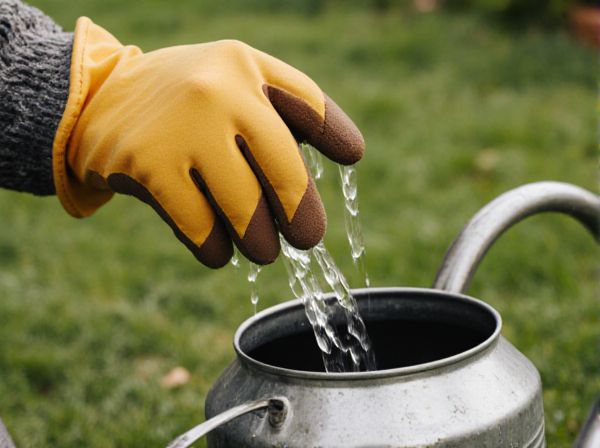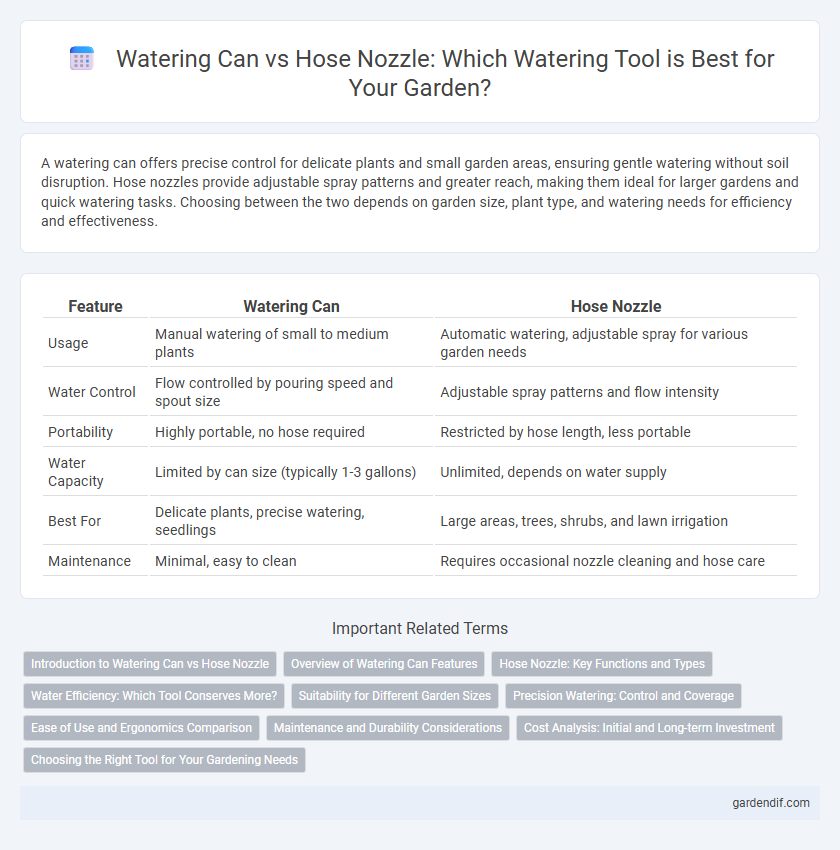
Watering Can vs Hose Nozzle Illustration
A watering can offers precise control for delicate plants and small garden areas, ensuring gentle watering without soil disruption. Hose nozzles provide adjustable spray patterns and greater reach, making them ideal for larger gardens and quick watering tasks. Choosing between the two depends on garden size, plant type, and watering needs for efficiency and effectiveness.
Table of Comparison
| Feature | Watering Can | Hose Nozzle |
|---|---|---|
| Usage | Manual watering of small to medium plants | Automatic watering, adjustable spray for various garden needs |
| Water Control | Flow controlled by pouring speed and spout size | Adjustable spray patterns and flow intensity |
| Portability | Highly portable, no hose required | Restricted by hose length, less portable |
| Water Capacity | Limited by can size (typically 1-3 gallons) | Unlimited, depends on water supply |
| Best For | Delicate plants, precise watering, seedlings | Large areas, trees, shrubs, and lawn irrigation |
| Maintenance | Minimal, easy to clean | Requires occasional nozzle cleaning and hose care |
Introduction to Watering Can vs Hose Nozzle
Watering cans provide controlled, gentle watering ideal for delicate plants and container gardens, while hose nozzles offer adjustable spray patterns suitable for broader watering tasks and garden maintenance. The watering can's portability and precision make it a favorite for indoor plants and small outdoor areas, whereas hose nozzles connect directly to garden hoses for efficient watering of larger landscapes. Choosing between these tools depends on garden size, plant sensitivity, and water delivery preferences.
Overview of Watering Can Features
Watering cans offer precise water delivery with their spout design, enabling targeted irrigation ideal for potted plants and small garden sections. Typically made from lightweight plastic or metal, they ensure easy handling and portability, while varying capacities provide flexibility for different watering needs. Their simplicity and control make them a reliable choice for gardeners seeking efficient manual watering tools.
Hose Nozzle: Key Functions and Types
Hose nozzles enhance garden watering efficiency by offering adjustable spray patterns such as mist, jet, and shower to suit various plant needs. Key functions include controlling water pressure, conserving water, and enabling precise targeting to prevent overwatering and soil erosion. Popular types range from pistol grip and dial control to multi-pattern nozzles, each designed for user comfort and versatility in different gardening tasks.
Water Efficiency: Which Tool Conserves More?
Watering cans deliver water directly to plant roots, minimizing evaporation and runoff, which enhances water efficiency in garden care. Hose nozzles, while convenient for broader coverage, often result in higher water waste due to spray dispersion and oversaturation. Therefore, for precise watering needs, a watering can conserves more water compared to hose nozzles.
Suitability for Different Garden Sizes
Watering cans excel in small to medium-sized gardens where precise watering around delicate plants is necessary, offering controlled water flow without waste. Hose nozzles are better suited for larger gardens, providing adjustable spray patterns and higher water pressure to cover extensive areas efficiently. Choosing between the two depends on garden size, plant type, and watering frequency for optimal irrigation.
Precision Watering: Control and Coverage
Watering cans provide precise control for targeted watering, ideal for delicate plants and container gardening. Hose nozzles offer adjustable coverage patterns, allowing gardeners to switch between focused streams and wide sprays for versatile watering needs. Choosing between the two depends on the balance between precision and area coverage required in your garden.
Ease of Use and Ergonomics Comparison
Watering cans offer straightforward control and a gentle water flow, ideal for precise watering but may become heavy when filled, impacting ease of use. Hose nozzles provide adjustable spray patterns and often feature ergonomic grips, reducing hand strain during extended use while connecting to a hose increases mobility and convenience. The choice depends on task size and user preference for handling comfort and water delivery precision.
Maintenance and Durability Considerations
Watering cans require minimal maintenance, typically needing occasional cleaning to prevent mineral buildup, making them highly durable with no moving parts prone to failure. Hose nozzles, while offering adjustable spray patterns and greater reach, demand regular upkeep such as cleaning internal filters and lubricating seals to avoid leaks and corrosion, which can affect their longevity. Choosing between the two depends on durability preferences and willingness to perform routine maintenance for optimal performance.
Cost Analysis: Initial and Long-term Investment
Watering cans involve a lower initial cost, typically ranging from $10 to $30, making them ideal for small gardens or container plants. Hose nozzles have a moderate upfront price between $15 and $50 but provide long-term savings through efficient water use and durability. Over time, hose nozzles reduce water bills and maintenance costs, offering a better return on investment for larger gardening needs.
Choosing the Right Tool for Your Gardening Needs
Selecting the right watering tool depends on your garden's size and plant type; a watering can offers precise control for delicate plants and small areas, while a hose nozzle provides adjustable spray settings suitable for larger gardens and varied watering needs. Watering cans are ideal for container plants and seedlings, ensuring gentle watering without soil disturbance. Hose nozzles with multiple spray patterns enhance efficiency by covering extensive areas quickly and conserving water through targeted application.
Watering Can vs Hose Nozzle Infographic

 gardendif.com
gardendif.com